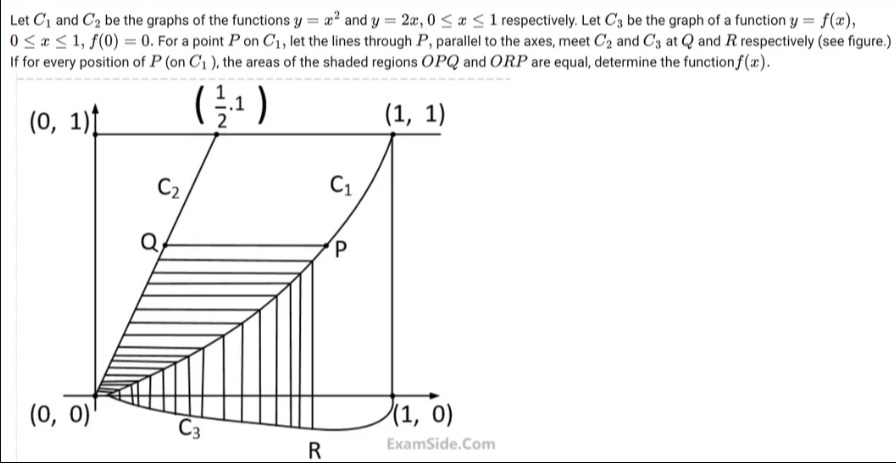Question
Question: Let $C_1$ and $C_2$ be the graphs of the functions $y=x^2$ and $y=2x$, $0 \leq x \leq 1$ respectivel...
Let C1 and C2 be the graphs of the functions y=x2 and y=2x, 0≤x≤1 respectively. Let C3 be the graph of a function y=f(x), 0≤x≤1, f(0)=0. For a point P on C1, let the lines through P, parallel to the axes, meet C2 and C3 at Q and R respectively (see figure.)
If for every position of P (on C1), the areas of the shaded regions OPQ and ORP are equal, determine the function f(x).

f(x)=\frac{x^3}{2}
Solution
We start by letting
P=(a,a2)(0≤a≤1)since P lies on C1:y=x2.
Step 1. Finding Q:
The horizontal line through P has equation
y=a2.This line meets C2:y=2x when
a2=2x⟹x=2a2.Thus,
Q=(2a2,a2).Step 2. Finding R:
The vertical line through P is x=a. It meets C3:y=f(x) at
R=(a,f(a)).We are given f(0)=0.
Step 3. Area Calculation:
The two shaded regions are triangles:
- △OPQ with vertices O=(0,0), P=(a,a2), Q=(2a2,a2).
- △ORP with vertices O=(0,0), R=(a,f(a)), P=(a,a2).
Using the determinant formula for the area of a triangle with vertices (x1,y1) and (x2,y2),
Area=21∣x1y2−y1x2∣,we find:
For △OPQ:
AreaOPQ=21a⋅a2−a2⋅2a2=21(a3−2a4)=2a3−4a4.For △ORP:
AreaORP=21a⋅f(a)−a2⋅a=21af(a)−a3.Since the figure suggests that f(a)<a2 (so that the vertical segment PR is downward), we have:
∣af(a)−a3∣=a(a2−f(a)).Thus,
AreaORP=2a(a2−f(a)).Step 4. Equating the Areas:
The condition states:
AreaOPQ=AreaORP.Thus,
2a3−4a4=2a(a2−f(a)).Multiply both sides by 2:
a3−2a4=a(a2−f(a))=a3−af(a).Subtract a3 from both sides:
−2a4=−af(a).Multiply both sides by −1:
2a4=af(a).For a=0, dividing both sides by a:
f(a)=2a3.Since a was any value in [0,1], we have:
f(x)=2x3for0≤x≤1.